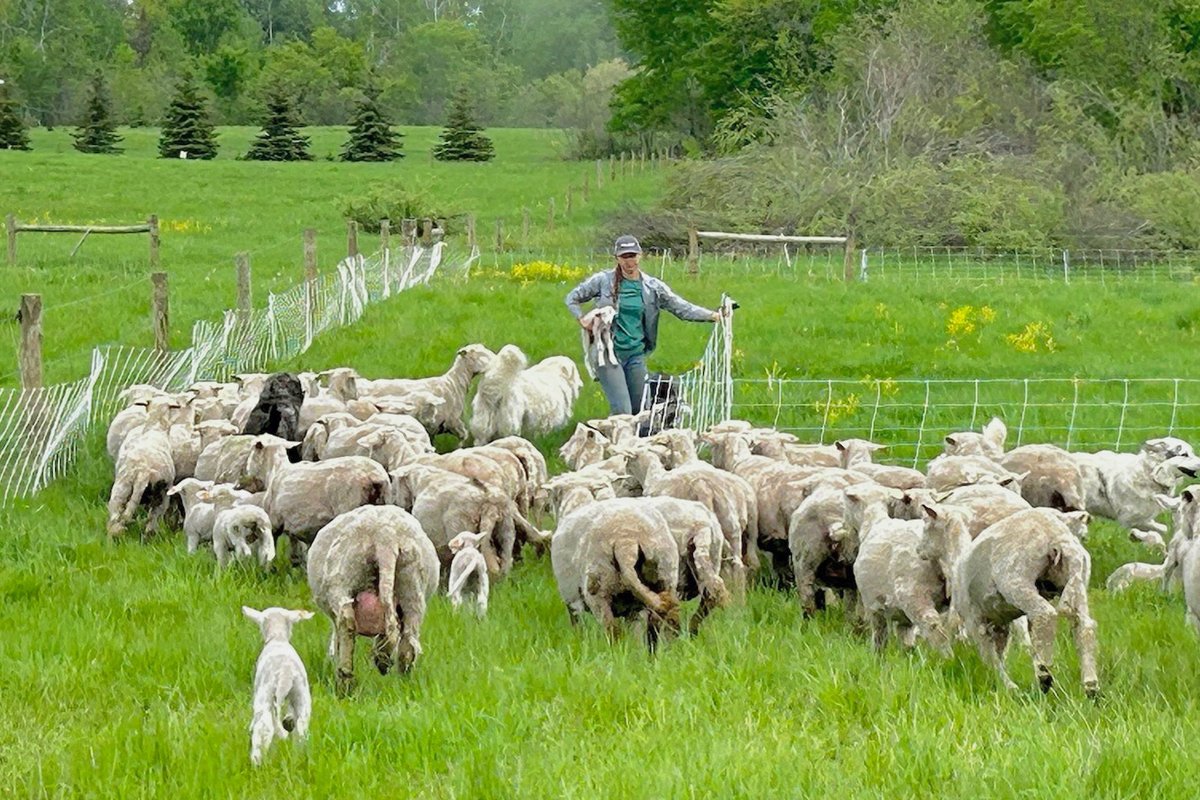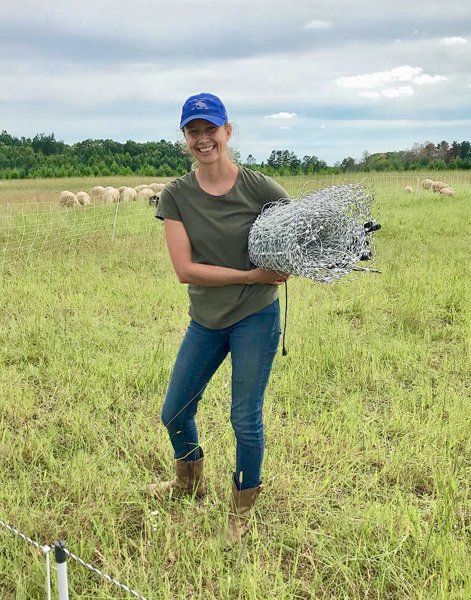Republicans in Washington are using farm bill negotiations to redirect billions of dollars in IRA funding away from climate-smart farming and toward business-as-usual commodity programs.

Republicans in Washington are using farm bill negotiations to redirect billions of dollars in IRA funding away from climate-smart farming and toward business-as-usual commodity programs.
October 12, 2023

Farmer Hannah Bernhardt purchased and converted a piece of degraded land with no infrastructure into a highly diversified grass-based farm with the help of conservation funding. (Photo courtesy of the farmer)
As Congress let the last farm bill expire at the end of September, I was navigating an ongoing drought on my Iowa farm for the third year in a row.
Iowa is known for its lush, green summers and abundant rivers and streams. Today, most of those streams are dried up and the rivers are at all-time lows. The soft rains we used to see from April to October are gone and now we’re facing longer bouts of drought, high heat events, torrential downpours, and polar vortexes. Because of climate change, the state is now colder than Alaska in the winter and hotter than Arizona during some parts of the year.
“Despite the ongoing droughts, floods, heat waves, and fires—and their ensuing costs to taxpayers—there’s still no consensus among lawmakers about the value of helping farmers achieve resilience in the face of climate change.”
In this corner of the state, we’ve only had 10 inches of rain since May 1; typically we would have had closer to 30 inches by now. In the first week of October, we had several unusually dry and windy 90-degree days that resulted in a field fire sparked by a combine.
These conditions are just one piece of a much larger puzzle. By September 2023, the U.S. had already seen 23 billion-dollar disasters fueled by climate change that year alone. Each year the number exceeds the year prior, yet there is little talk or action on mitigation and prevention.
Meanwhile, it may be months before lawmakers can agree on a new farm bill. And as their negotiations set the stage for the next five years of American agriculture, it can feel to farmers like our future is in their hands. Despite the ongoing droughts, floods, heat waves, and fires—and their ensuing costs to taxpayers—there’s still no consensus among lawmakers about the value of helping farmers achieve resilience in the face of climate change.
Many of us, however, are taking matters into our own hands. On the parts of my farm where I’ve been able to plant trees and perennial plants and grasses, that deep-rooted living cover is still providing a lifeline to moisture and minerals. I’ve been slowly expanding the land on which I’m using these conservation practices, and I’ve witnessed how resilient the area has become to unpleasant climate extremes.
And yet, here in Iowa, and in a number of other states, policies that invest in climate-smart farming practices are often written off as “climate alarmism.” And that resistance to talking about the crisis is also playing out in the farm bill negotiations themselves.
Last year, the Inflation Reduction Act (IRA) included $20 billion that was to be used to shore up four federal conservation programs: the Conservation Stewardship Program (CSP), the Environmental Quality Incentives Program (EQIP), the Agricultural Conservation Easement Program (ACEP), and the Regional Conservation Partnership Program (RCPP). While these programs haven’t always been used to make farms climate resilient, they all have the potential to do so—and more funding and specific guardrails specified within the IRA would make that even more likely.
Earlier this year, a group of GOP Congressmembers began proposing that Congress use the farm bill reauthorization process as an opportunity to redirect these resources away from increasingly popular climate-focused conservation programs and instead add them to the general farm bill budget.
The proposal has since picked up speed and multiple advocacy groups have been pushing back. In August, Michael Lavender, policy director for the National Sustainable Agriculture Coalition (NSAC) said in a statement: “For the hundreds of thousands of farmers turned away from underfunded conservation programs in recent years, the Inflation Reduction Act’s historic investment in climate-friendly agriculture means an opportunity to be productive, good stewards of the land while driving climate mitigation and adaptation.”
The effort to redirect the funds is frustrating for farmers like me, who saw the IRA investment as a much-delayed recognition that diversity of plants, animals, and people is the key to resiliency against climate change, and that soil health is a priority so we still have enough soil in 60 years to feed people. It is an effort to put money up front that could eventually prevent us from spending so much in the long run. It would insulate us against extreme weather and help us build a stronger, more resilient America.
At the same time, Senator Debbie Stabenow (D-Michigan), chair of the Senate Ag Committee, is proposing that the $10.5 billion in conservation funding within the IRA be placed into the farm bill baseline funding and remain earmarked for conservation. Over time, she says it would increase to $30 billion in conservation funding available for the next two farm bills (a 10-year period) and be considered one of the biggest victories in conservation farming in recent history. Building the baseline, advocates say, would mean more money for conservation in the long run.
If those funds are left in the IRA, on the other hand, they will be vulnerable to attack in every appropriations cycle. GOP lawmakers want to beef up the safety net in the farm bill for a handful of commodity crops: corn, soybeans, wheat, cotton, rice, and peanuts. They want a business-as-usual farm bill, and they’re not considering the powerful ways diversity and conservation can go hand in hand to help prevent potential losses.
For instance, the House Ag Committee Chairman, GT Thompson (R-Pennsylvania), is interested in moving the IRA conservation dollars to fund what would cover reference pricing (if the price of a commodity crop falls below a certain point, farmers receive payments to make up the difference). That funding typically supports a limited number of farmers in the South who grow rice, cotton, and peanuts.
According to Jesse Womack, a policy specialist at NSAC, the conservation practices that were flagged and funded within the IRA were selected by the National Resource Conservation Service (NRCS) to restore wildlife habitat, improve soil health, and create better approaches to water quality—issues that lawmakers both sides of the aisle say they support.
These practices also just so happen to mitigate many of the worst impacts of climate change. The IRA conservation dollars fund programs that offer direct financial support to new and existing practices on farms and they are much more inclusive than commodity programs.
Funding more and better conservation practices also helps grow farmers and protect farmland. Since the 1980s, we’ve lost an astounding number of farmers, and lawmakers on both sides of the aisle say they want to see more farmers on the land. As a beginning farmer, I have been able to grow a direct-to-consumer business with the help of EQIP and CSP and I get to tell that story to my customers every day.
I’ve converted cropland to grassland, transitioned to organic, planted more than 6,000 trees and shrubs as well as perennial grains like Kernza, started rotationally grazing livestock, and added fencing and waterlines—all while making a home for a diversity of wildlife.

New farmer Hannah Bernhardt says EQIP funding paid for fences and waterlines at her farm in Finlayson, Minnesota, which allowed her to grow her herd of cattle. (Photo courtesy of the farmer)
And there are many other farmers out there doing similar work. Hannah Bernhardt, a beginning farmer from Finlayson, Minnesota, was able to purchase and convert a piece of degraded land with no infrastructure to a highly diversified grass-based farm with the help of conservation funding.
“If we hadn’t had EQIP dollars for fences and waterlines I’d probably be burnt out by now. It gave me hours of my day back to have proper infrastructure instead of using all temporary fences and having to haul water,” she told me. These tools allowed Bernhardt to grow her herd of cattle, which she says, “significantly impacted our gross sales and made us a real farm business—not a hobby farm.”
Seth Watkins, a farmer from Clarinda, Iowa, was able to save his family farm with the help of conservation funding. He built new ponds, and improved his grazing system and his skills with cost-share and technical assistance.
“The CSP program created incentives to [help me] learn new farming practices—including planting cover crops, integrating legumes in pastures, and using integrated pest management—that all have helped me reduce my need for chemicals, synthetic fertilizers, and equipment, and improved my profitability by improving the resilience of my farm.”
Farmers like Bernhardt, Watkins, and I are now left wondering what our fate will be. We don’t have the support programs that commodity farmers do and it’s looking like this new farm bill might ultimately preserve the current system, rather than providing us with added support as we had hoped it would.
On the other hand, if the IRA dollars remain tied to conservation funding, it will help move America’s agriculture in the direction it needs to go over the next decade as the climate crisis intensifies. Climate scientists have predicted that Earth is on target to pass the 1.5 °C target set by global leaders (meaning it will be 1.5 °C warmer than pre-industrial levels), putting us on track to experience much more climate and weather extremes and disasters in the immediate future.
Farms need to become more resilient, and we need to mitigate the impending impacts of climate change while feeding our communities and protecting our precious soil, water, and air—so that we can continue to grow healthy food in the future for all Americans. To me, that’s not climate alarmism at all; it’s just common sense.

September 4, 2024
By paying top dollar for milk and sourcing within 15 miles of its creamery, Jasper Hill supports an entire community.
September 3, 2024

August 27, 2024

August 26, 2024

Like the story?
Join the conversation.